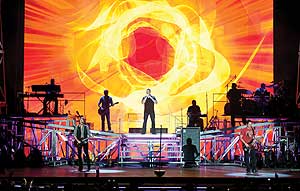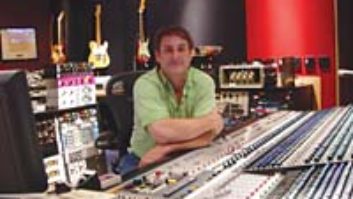
Country superstars Rascal Flatts (Gary Levox, lead vocals; Joe Don Rooney, vocals/lead guitar; and Jay DeMarcus, vocals/bass) are touring in support of their latest, Unstoppable. The trio is supplemented with a wonderful set of backing musicians, including drummer Jim Riley, keyboardist Tim Akers, guitarist Jonathan Trebing, steel and banjo player Travis Toy and fiddler John Jeansonne. Mix caught up with the act at the Sleep Train Amphitheatre (Wheatland, Calif.).

From left: Sound Image system tech/FOH tech James Burr, FOH engineer Jon Garber and Sound Image system tech/FOH tech Jeremy Peters
Front-of-house engineer Jon Garber is mixing on a Studer Vista, and says, “To pull up your EQ and move it just one dB and hear the difference is such a great thing. You don’t have to really work on the input EQ as much so you can work on mixing. Onstage we have about 78 inputs and the Studer handles that easily. It has all the dynamics onboard, but it doesn’t have any time-based stuff, so that gives me the option to pick out my own reverbs.”
Rack gear includes a dbx 160 on snare top. The vocal chains see a dbx 902 de-esser through a Drawmer DL441 Quad auto-compressor limiter. Reverb units are two Lexicon PCM 96s, three SPX 2000s, Eventide Eclipse Harmonizer, and a TC Electronic D2 and M5000. “Radial has really helped us out,” Garber says. “We use Radial J48 on all of our DIs. They gave us some extra stuff like the Radial Phazer adjustment tool, which is awesome for electric guitar.
“We’re fully endorsed by Shure, and Ryan Smith is another great person to work with. Any problems, and he’s there to help us out. We tried most of the microphones on the market before we settled with the Shure SM58, which we’re very happy with.”

From left: crew chief Pete McDonough, monitor engineer Stuart Delk and stage tech Jeremy Moore
Monitor engineer Stuart Delk is also on a Studer board—a Vista 5 SR. “I am hardcore analog, but this desk has the sound I would compare to high-end analog with all the digital capabilities. All the EQ and comp/gates are on the channel strip, and it’s all touchscreen to get what you need. I have the inputs that are on the splitters—one to one in this screen—so I can troubleshoot by channel if needed without going over to the split.
“Studer does not have any onboard reverbs or time-based effects. I carry nine outboard reverb units, four TC Electronic 4000s and five [Yamaha] SPX-2000s. They sound great with new and old factory settings. Most of my reverbs are custom programs I have made. I can also input stereo and output stereo via AES connections, keeping the signal chain all digital and using two XLR lines instead of four XLRs for each unit.”
His other rack carries wireless and combiner amps, including eight channels of Shure UHF-R mics for all vocals, 14 channels of in-ear monitors, eight Sennheiser G2 IEMs and six Shure PSM Series. The ProWireless combiners give Delk 250 mW of power for all ear systems.
According to drum tech Craig Krolicki, all mics on Jim Riley’s kit are Shure. (He has a Shure mic endorsement). Mics comprise Shure 98s (toms), Beta 27s (toms), SM57 (snare top), KSM137 (snare bottom), KSM 137 (hi-hat, overheads), 57s (Octobans, 20-inch kick), Beta 52 (24-inch kick) and Beta 91 (24-inch kick). He sings through a Shure 58.
Bass tech Robert “Bucky” Huck says that bassist Jay DeMarcus’ rig comprises an Avalon 737 through a Distressor EL8-X comp and an Ampeg SVT Classic through a Distressor EL8-X comp and a Palmer PDI-03 direct box. “It starts with three Shure UR4D dual wirelesses into an Amp Gizmo custom splitter I had them design with eight ins and four outs,” Huck says. “One out goes to the Ampeg side and one out goes to the Avalon side. I also have a second rig built in the rack for our pedal-steel player, Travis Toy. He plays bass when Jay is on keyboards. His rig is completely separate on the Avalon side, but they both share the Ampeg side with the use of a Tour Supply Amp Selector.”
Jonathan Trebing’s rig comprises a Sennheiser G3 wireless and a 100-watt Marshall Super Lead driving a 4×12 Bogner cabinet miked with a Sennheiser 421.
Rex Frazier techs for guitarist Jonathan Trebing, keyboardist Tim Ackers, John Jeasone (fiddle, mandolin, guitar) and Travis Toy (pedal steel, banjo, guitars).
The Sound Image–provided P.A. comprises 78 JBL VerTec 4889s for high packs and 32 VerTec 4880s for subs. According to Garber, the arena shows have four stacks per side. Front-fills are Sound Image WideLine boxes, 12 across the stage. The system is controlled by three Dolby Lakes.
Joe Don Rooney’s guitar tech, David Graef, describes the guitarist’s rig as “a fun one. It’s a dry/wet/dry rig with a center 4×12 cabinet, with just the dry amp and two Mathers 1×12 cabinets for the effect left and right signals. We start with two dual Shure UR4D wireless units that go into a line selector made by RJM Technology. From the selector, the signal goes to my pedal board, where I do the majority of his patch changes, and then returns to an amp selector that feeds signal to one of two Bogner Ecstasy 101B heads [miked with three Shure SM57s and a Royer ribbon, pictured], a Blackstar Series One 200 head and a Diamond Decada head, and then out to the 4×12 dry cabinet. I take a line-level signal and feed the outboard effects [TC Electronic D-Two, Fireworx and Reverb 4000]. They return to and are blended through a Midas Venice 160 console and sent to a VHT 292 amp that powers the two Mathers 1×12 cabinets onstage for the wet signal.
“We separate the dry amp and the wet left and right signals to maintain the cut of the guitar in the mix.”
There are two pedalboards, one of which Graef uses to control the rig through most of the show. On his board are the Ground Control Pro for all MIDI program switching, an RJM Technology Amp Gizmo for amp channel changes (via MIDI), a Micro POG, Diamond Tremolo, Xotic EP Booster, Boss AW-1 and an Ernie Ball VP Jr. Rooney’s pedal board onstage sees another Ground Control Pro, a tuner, Earnie Ball VP Jr. and a Dunlop Wah controller—all connected to the Dunlop Rack Wah for onstage control of volume and wah.


